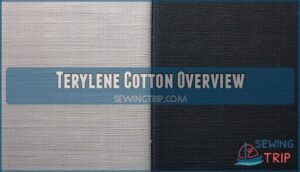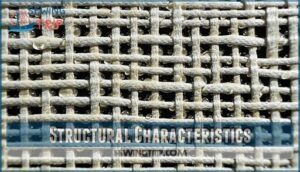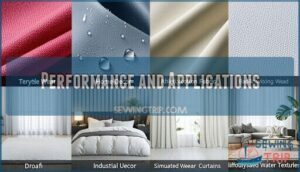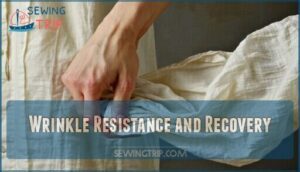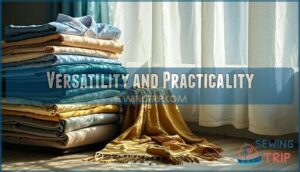This site is supported by our readers. We may earn a commission, at no cost to you, if you purchase through links.
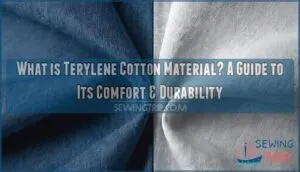 Terylene cotton is a hybrid fabric that combines synthetic polyester (terylene) with natural cotton fibers.
Terylene cotton is a hybrid fabric that combines synthetic polyester (terylene) with natural cotton fibers.
You’ll love this blend because it brings together polyester’s durability and wrinkle resistance with cotton’s breathability and comfort.
Think of it as the best of both worlds in textile form.
It’s commonly used in shirts, pants, and bedding where you need fabrics that can stand up to regular washing without losing shape.
The material wicks moisture away while still feeling soft against your skin, making it perfect for everyday wear.
There’s much more to discover about how this versatile fabric might be the unsung hero in your wardrobe.
Table Of Contents
Key Takeaways
- You’ll get durability and wrinkle resistance from polyester combined with cotton’s softness and breathability in terylene cotton.
- It’s easy to care for, resists stains, and keeps its shape and color even after frequent washing.
- The fabric wicks moisture effectively, dries quickly, and prevents skin irritation, making it ideal for everyday wear.
- Terylene cotton is versatile, used in clothing, home textiles, and even outdoor gear due to its strength and comfort.
Terylene Cotton Overview
Terylene cotton blends the durability of polyester with the softness and breathability of cotton, creating a fabric that’s both tough and comfortable.
It’s known for resisting wear and tear, staying easy to care for, and keeping its shape and color through frequent use, making it a durable choice.
Composition and Properties
Understanding terylene cotton composition means exploring its fiber ratios—usually 65% polyester and 35% cotton.
This blend variation combines polyester’s resilience with cotton’s breathability. The fabric composition offers exceptional textile properties like wrinkle resistance and softness.
Terylene cotton properties include a balanced texture analysis and material weight, delivering durability and comfort. It’s ideal for long-lasting, easy-care applications.
Moisture Absorption and Comfort
When it’s hot or you’re sweating, Terylene cotton keeps you comfy by balancing moisture absorption and fabric breathability.
Its polyester-cotton mix wicks sweat while staying soft. Plus, it dries quickly, preventing skin irritation.
Here’s why it stands out:
- Sweat absorption keeps you dry.
- Superior fabric comfort for all-day wear.
- Avoids skin irritation.
- Works in humid or ideal climates.
- Great for sweat management.
It is notable for its ability to provide superior fabric comfort, making it an excellent choice for various conditions.
Durability and Ease of Care
Terylene cotton durability is impressive, offering strong tear resistance and shape retention, even after repeated washing.
It handles stains well and reduces ironing needs with its built-in wrinkle resistance.
Fabric care is simple—just wash, dry, and wear.
Compared to fabrics that lose form or fade, this blend keeps its charm intact, making it a reliable choice for everyday use with strong tear resistance.
What is Terylene Cotton
Terylene cotton is a clever fabric blend combining polyester and cotton fibers, offering the best of both materials.
Terylene cotton combines polyester’s strength with cotton’s softness, delivering a durable, breathable fabric perfect for comfort and everyday use.
Usually, it features fiber ratios like 65%-67% polyester and 33%-35% cotton, though other variations, like 80/20, exist.
This balance brings together polyester’s durability and wrinkle resistance with cotton’s softness and breathability.
If you’ve ever worn a shirt that felt soft yet sturdy, it might’ve been a polyestercotton mix like Terylene cotton.
What makes this duo special is its versatility and practicality in material weaves, making it one of textile innovation’s gems.
Whether you’re sweating through summer heat or tackling laundry day, Terylene cotton holds its shape, feels cozy, and keeps you cool.
Its unique construction guarantees comfort without sacrificing strength.
Given its polyester composition, it boasts superior fabric strength.
Terylene Fabric Characteristics
When you look at Terylene fabric, you’ll notice its unique mix of strength and comfort, thanks to its polyester and cotton blend.
It’s lightweight, resists wrinkles, and keeps you cool, making it both practical and reliable for daily use.
Structural Characteristics
Terylene cotton’s fabric structure is tight yet soft, balancing comfort with durability.
Its blend composition promotes moisture spread and quick evaporation, keeping you dry during activities. Plus, the fabric construction offers wrinkle resistance and excellent recovery performance.
- **Fabric weave guarantees breathability and strength.
- **Recovery performance prevents lasting wrinkles.
- **Moisture spread keeps sweat moving outward efficiently.
Performance and Applications
Terylene cotton shines in sports apparel and outdoor gear, thanks to its moisture-wicking and breathable fabric performance.
It’s also a favorite for home decor, like curtains and bedding, blending durability with comfort.
Industrial uses, including upholstery and medical textiles, highlight its strength.
These fabric applications in daily wear and beyond showcase the versatility of terylene cotton uses.
Wrinkle Resistance and Recovery
Terylene cotton’s wrinkle resistance is a lifesaver for people who hate ironing.
This fabric blend has excellent crease recovery and fabric memory, meaning it bounces back to shape after folds.
Its wrinkle reduction properties save time and hassle, keeping your clothes looking neat.
With fabric wrinkle resistance and exceptional wrinkle recovery, it’s all about easy care and dependable shape retention.
Terylene Cotton Applications
You’ll find Terylene cotton in everything from sportswear to home decor, thanks to its balance of comfort and durability.
Its versatility makes it a go-to choice for active lifestyles and practical household items alike.
Sports and Outdoor Wear
When you’re gearing up for intense activities, terylenecotton sportswear has your back.
Its moisture absorption and breathability keep you cool, while the fabric’s weather resistance tackles unpredictable conditions.
Perfect for performance apparel and outdoor adventures, it balances durability needs with activity comfort.
You can find various teryelene cotton products online.
Plus, its lightweight design makes layering systems easy, ensuring you’re ready for anything.
Home Textiles and Decor
For home textiles, Terylene cotton shines with its practicality and longevity.
Its fabric blend applications guarantee durability and vibrant color retention, even with frequent use.
For superior comfort, consider options with long fibers for softness.
You’ll find it perfect for household applications like:
- Curtains: Sunlight resistance keeps them looking fresh.
- Tablecloths: Easy to clean and maintain.
- Upholstery: Withstands daily wear.
- Bed linens: Soft yet durable.
- Decor accents: Adds stylish functionality.
Versatility and Practicality
With its fabric versatility and practicality, this blend shines in everyday applications.
From sporty gear to cozy home decor, its design adaptability fits countless fabric applications.
The blending benefits of polyester’s durability and cotton’s comfort make it cost-effective for various fabric blend uses.
You can even find various Terylene cotton blends online.
User preferences often favor its balance of style and function, making it a go-to choice.
Terylene Cotton Benefits
You’ll appreciate how Terylene cotton blends durability with comfort, making it a practical choice for daily wear.
Its moisture-wicking properties and easy care features guarantee you stay comfortable while keeping maintenance simple, with comfort being a key aspect.
Balance of Durability and Comfort
When you wear terylenecotton, you’re getting the best of both worlds.
This fabric blend comfort strikes the perfect balance between polyester’s strength and cotton’s softness.
- Comfort vs. Strength: Won’t make you choose between feeling good and lasting long
- Blend Optimization: 65%-67% polyester with 33%-35% cotton for ideal performance
- Activity Suitability: Holds up during sports while keeping you comfortable
- Seasonal Usage: Works year-round, especially in variable conditions
- User Perception: Most people can’t tell it’s not 100% cotton by touch alone
Moisture-Wicking Properties
Beyond durability and comfort, terylenecotton shines in its moisture-wicking properties.
When you’re active, this fabric pulls sweat away from your skin and spreads it across the material for faster evaporation.
You’ll stay dry and comfortable even during intense workouts.
The polyester component handles the moisture transfer while cotton’s natural breathability guarantees air circulation, creating the perfect balance for temperature regulation in any climate.
Easy Care and Maintenance
While terylenecotton wicks away moisture, you’ll also love how easy it’s to care for.
You can toss your terylene cotton items in the washing machine without worry—they’ll maintain their shape and color even after numerous cycles.
Stain removal is typically straightforward, and the fabric’s wrinkle resistance means minimal ironing needs.
To prevent damage, consider using gentle detergents during washing.
For maximum longevity, store your items flat or hung to preserve their quality.
Terylene Cotton Sustainability
You’ll be happy to know that terylene cotton can be produced using recycled materials, reducing waste and the demand for virgin polyester in the textile industry.
This eco-friendly blend appeals to environmentally conscious consumers while still offering the perfect balance of durability and comfort that you need in your everyday fabrics.
Environmental Benefits
Several key environmental benefits make terylenecotton a smart choice for eco-conscious consumers.
The sustainable blend substantially reduces environmental impact compared to conventional fabrics:
- Minimizes energy and water consumption during production
- Lowers greenhouse gas emissions by up to 46% when using organic cotton components
- Decreases the overall carbon footprint through extended product lifespan
This fabric sustainability sweet spot balances performance with reduced textile impact on our planet.
Recycled Materials and Waste Reduction
When you choose terylene cotton made from recycled materials, you’re helping divert waste from landfills.
These sustainable blends combine recycled polyester (often from plastic bottles) with repurposed cotton fibers, substantially reducing fabric waste.
Textile recycling transforms what would be trash into new, functional materials—saving resources while maintaining quality.
You can find various recycled cotton products online.
The eco-consciousness behind fabric recyclability makes terylene cotton an environmentally responsible choice for both manufacturers and consumers.
Eco-Friendly Textile Options
As recycled materials gain traction, you’ll find more eco-friendly textile options entering the market.
Sustainable blends combining recycled polyester with organic cotton offer the same benefits as traditional terylene cotton while reducing environmental impacts.
These ecofriendly textiles support ethical production methods and minimize textile waste.
When shopping, look for certifications that verify fabric ecofriendliness—they’re your best guide to making environmentally responsible choices without sacrificing quality or comfort.
Some certifications, like GOTS certification, guarantee the fabric meets strict environmental and social criteria.
Frequently Asked Questions (FAQs)
Is terylene a good fabric?
To put it simply, terylene fabric offers you bang for your buck.
It’s durable, wrinkle-resistant, and dries quickly.
When blended with cotton, it’s even better—combining strength with comfort for everyday wear.
What is terylene cotton?
Terylene cotton is a fabric blend combining polyester (terylene) and natural cotton.
You’ll find it offers polyester’s durability and wrinkle resistance with cotton’s softness and breathability—giving you clothing that’s both comfortable and long-lasting.
What are the disadvantages of terylene?
Like a wolf in sheep’s clothing, terylene lacks breathability and can make you sweat.
It’s not as comfortable as natural fibers, is prone to static electricity, and can irritate sensitive skin.
Is terylene fabric safe to wear?
Yes, terylene fabric is generally safe to wear.
You’ll find it’s non-toxic and won’t irritate your skin.
It’s commonly blended with cotton to create comfortable, durable clothing that’s both breathable and practical.
Is Terylene Environmentally Friendly?
While terylene isn’t fully eco-friendly since it’s synthetic, it’s becoming greener through recycling initiatives. You’ll find it’s more sustainable when blended with cotton, balancing durability with reduced environmental impact.
Does Terylene Absorb Moisture?
Think of a sponge that’s playing hard to get – that’s terylene.
It doesn’t absorb moisture well on its own, but when blended with cotton to create terylene cotton, you’ll get improved moisture-wicking properties.
Is Terylene Fabric Colorfast?
Terylene fabric holds its colors extremely well.
You’ll find your garments maintain their vibrant hues even after multiple washes, as the polyester component in terylene resists fading from both sunlight exposure and regular laundering, which helps the fabric maintain its vibrant appearance.
Is Terylene Fabric Flammable?
Imagine a fabric that resists flames but melts when exposed to high heat—Terylene does just that.
It’s not easily flammable, yet it can char or melt, requiring caution near open flames.
Certain treatments can improve the fabric’s safety, offering enhanced flame retardancy with flame resistance properties.
Can Terylene Be Dyed?
Yes, you can dye Terylene, but it requires disperse dyes and high heat due to its polyester content.
Be patient—it’s not as straightforward as cotton, but the results are vibrant and long-lasting!
How to dye terylene cotton at home?
To dye terylene cotton at home, use a polyester-compatible dye for the terylene and fiber-reactive dye for the cotton.
Heat is essential, so boil water for polyester dyeing, then rinse and air-dry gently.
Conclusion
In the context of fabrics that balance practicality and comfort, terylenecotton material quietly excels.
This blend offers the durability and wrinkle resistance of polyester while keeping the softness and breathability of cotton.
It’s a smart choice for everyday wear, home textiles, or even activewear, thanks to its moisture-wicking properties and ease of care.
Whether you’re tackling laundry day or just staying comfortable, terylene cotton proves its worth without demanding extra effort from you.
- https://patentimages.storage.googleapis.com/d9/36/3e/c6365505978fba/CN202007301U.pdf
- https://worldwide.espacenet.com/publicationDetails/biblio?CC=CN&NR=202007301U&KC=U&FT=D
- https://globaldossier.uspto.gov/result/application/CN/201120055887/1
- https://sewwhatinc.com/resources/flame-retardancy/fabric-flammability/

